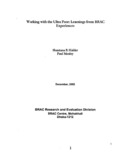Working with the ultra poor: learnings from BRAC experiences
Citation
Halder, S. R., & Mosley, P. (2002, December). Working with the ultra poor: learnings from BRAC experiences. Research Reports (2002): Economic Studies, Vol - XVIII, 1–24.Abstract
This paper describes BRAC experiences of working with the ultra poor over the last two
· decades. The ultra poor is the poorest section among the population with a few or no asset base,
highly vulnerable to any shocks and mainly depending on wage labour. The main causes of their
poverty, especially in the rural areas, are poverty inheritance, loss of income earner and ill
health. Although microfinance is targeted to the poor, the ultra poor lacking livelihood resources
are reluctant to borrow credit with the fear of being overburdened. They need a critical push to
uplift their initial endowment base to a certain level which is necessary for getting greater access to
other resources and their productive utilization. The BRAC Income Generation for Vulnerable
Group Development (IGVGD) follows that kind of approach for creating a missing links in the
ladder that helps the poor to participate in the manifolds of the development process. IGVGD is an
integrated package of food distribution, savings, micro-credit provision, social awareness-building
and skill development training and essential health care interventions. Different study findings
conducted within the county and outside indicate that IGVGD is very successful and also costeffective
in reaching the ultra poor. But what is important to note that the female coming from male
headed households can participate more fully in the IGVGD programmne activities and it is the men
who use NGO credit and husbands' income are the primary source of installment payments. A
quarter of the IGVGD women did not gain any long term benefits. The the female-headed
households who lack resources were among those who could make less use of the services on offer
and, therefore, return to their destitution after the end of food ration. That means there is a need to
rethink further what fits better to this specific group of population. They need a critical push with a
view to unleashing a process that would allow them to exit the poverty trap and attain a more selfsustaining
livelihood. Challenging the frontiers of poverty (CFPR) is a special investment package of BRAC involves
giving selected women and their families productive assets such as cows, small grocery shops, or
poultry, specialized skill training on how to run a business with their asset, a stipend provision for
the first few months, subsidized healthcare as well as social support and confidence building
training. a new initiative of BRAC which There are also another 10% of the ultra poor who were
excluded from IGVGD for being too old or disabled. It means IGVGD can not address the specific
constraints of the most distressed women in Bangladesh.

